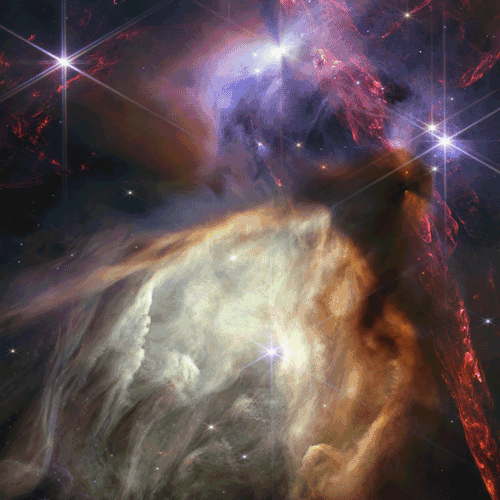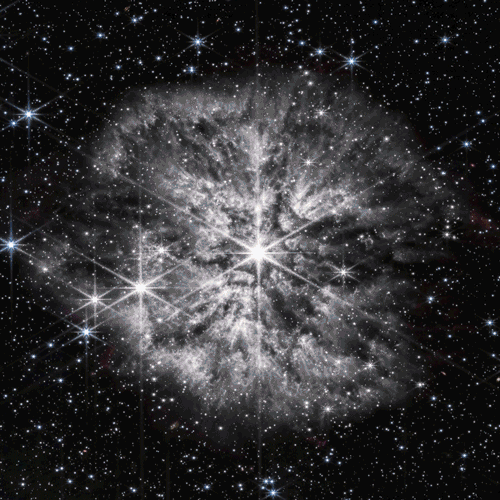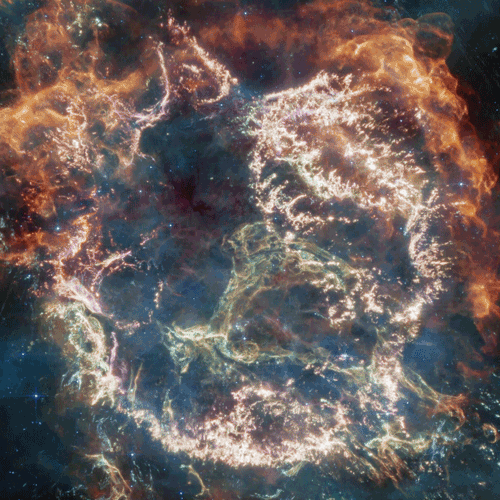
Stunning James Webb images show birth and death of massive stars
The James Webb Space Telescope continues to surprise us with stunning pictures, but of what exactly? Astronomer Nienke van der Marel shows with three images how massive stars lead short but explosive lives.
Snake Bearer
In this image, we can see Ophiuchus or the Serpent Bearer. ‘This star-forming region is a few million years old’, says Van der Marel. ‘These stars are still growing and planets are forming around them. A major part of my research focuses on this region.’

The different colours are created by the telescope’s different filters, Van der Marel explains. ‘Each filter is sensitive to a different type of material, which emits a different kind of light. The red you can see is hot hydrogen. When a star is formed, energy shoots in two directions, pushing gas from the surrounding cloud outwards. These are the red jets you can see in the image.’
We can also see some white dots of light. ‘These are young stars.’ And we also see a large arch. ‘That is the outermost part of a cavity caused by a young massive star, S1, which is in the centre of that cavity. S1 is more than 20 times more massive than our Sun. Stars like this release so much energy that they heat all the material around them to extreme temperatures, causing chemical reactions. This creates the cavity you can see, with a yellow rim of tiny dust particles.’
What catches Van der Marel’s eye most about this image? ‘Zoom in far enough and you will see a kind of hourglass. That’s what I find most interesting. It is a disk around a star that you are viewing from the side. The dust in the disk absorbs the light from the star and the material behind it. In this dust disk, some of the dust clumps together to form planets. We don’t yet know how exactly. That’s what I’m trying to figure out in my research.’
It takes millions of years for stars and planets to form. ‘We obviously don’t have time to observe their formation’, says Van der Marel. ‘So we study images of different stars of different ages and in different phases. Then we try to put them in the right order to see how planets and stars form. Images like these give us a good overview of several stars forming in the same environment.’
Wolf-Rayet 124
This is another image of a massive star but then in a later phase of its evolution, says Van der Marel. ‘In the middle, we can see what is known as a Wolf-Rayet star, a star that has consumed most of its hydrogen and already lost its atmosphere. At more than 20 times the mass of our Sun, it is an enormous star. And it is a million times brighter. Massive stars like this evolve quickly because they comprise so much material and lose mass rapidly.’

This star will explode in a few hundred thousand years, says Van der Marel. ‘On an astronomical time scale, its lifetime is very short. Massive stars explode at the end of their lives, what we call a supernova. Once the star has exploded, this picture will look very different. Their short lives make Wolf-Rayet stars very rare. There are only 500 in the entire Milky Way.’
Surrounding the star is a cloud of pink, brown and purple dust. ‘That dust has been blown away from the star’s surface. This picture will help us learn how these massive stars enrich heavier elements and dust particles. All the elements needed to form planets and life are created here. We can now study that for the first time.’
Cassiopeia
What remains of a massive star after it explodes? That is what we can see in this picture. ‘After a supernova has occurred, a cloud remains that is still visible for thousands of years. The orange and red material is hydrogen from interstellar matter that was pushed away when the star exploded. The lighter, pink material is probably the remnant of the star itself. So these are the elements and atoms that were created in the star.’

A supernova takes several weeks or months on average, Van der Marel explains. ‘This supernova happened about 350 years ago, so the material we are looking at has been stable for some time.’
In the middle, we can also see a green loop. What is it? ‘No one knows. It’s been nicknamed the “green monster”. Researchers were surprised to see it in the image. No one had expected it. It has never been observed before in the remnants of a supernova. One of the researchers who is working on this said in an interview that he will spend the rest of his career working on the data collected for this image. Astronomers often look at one thing and see something completely unexpected. That’s what makes our discipline so much fun.’
Text: Tom Janssen
Images: Fien Leeflang
Photos: NASA, ESA, CSA, STScI, Webb ERO Production Team
Nienke van der Marel
Assistant Professor Nienke van der Marel studies the formation of planets in the dust and gas surrounding young stars. ‘When a star forms, a flat disk of gas and dust often forms around the young star. In that disk, dust particles clump together to form planets.’ Van der Marel was recently awarded the New Horizons Prize for her research on ‘dust traps’ in these disks. This discovery enabled her to solve enduring problems in explaining planet formation.
